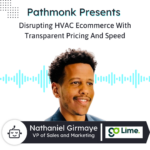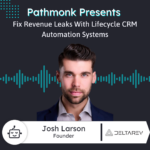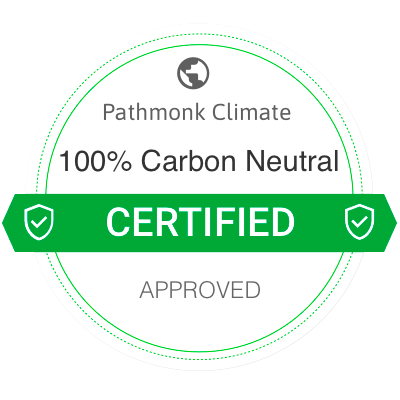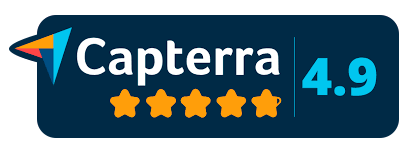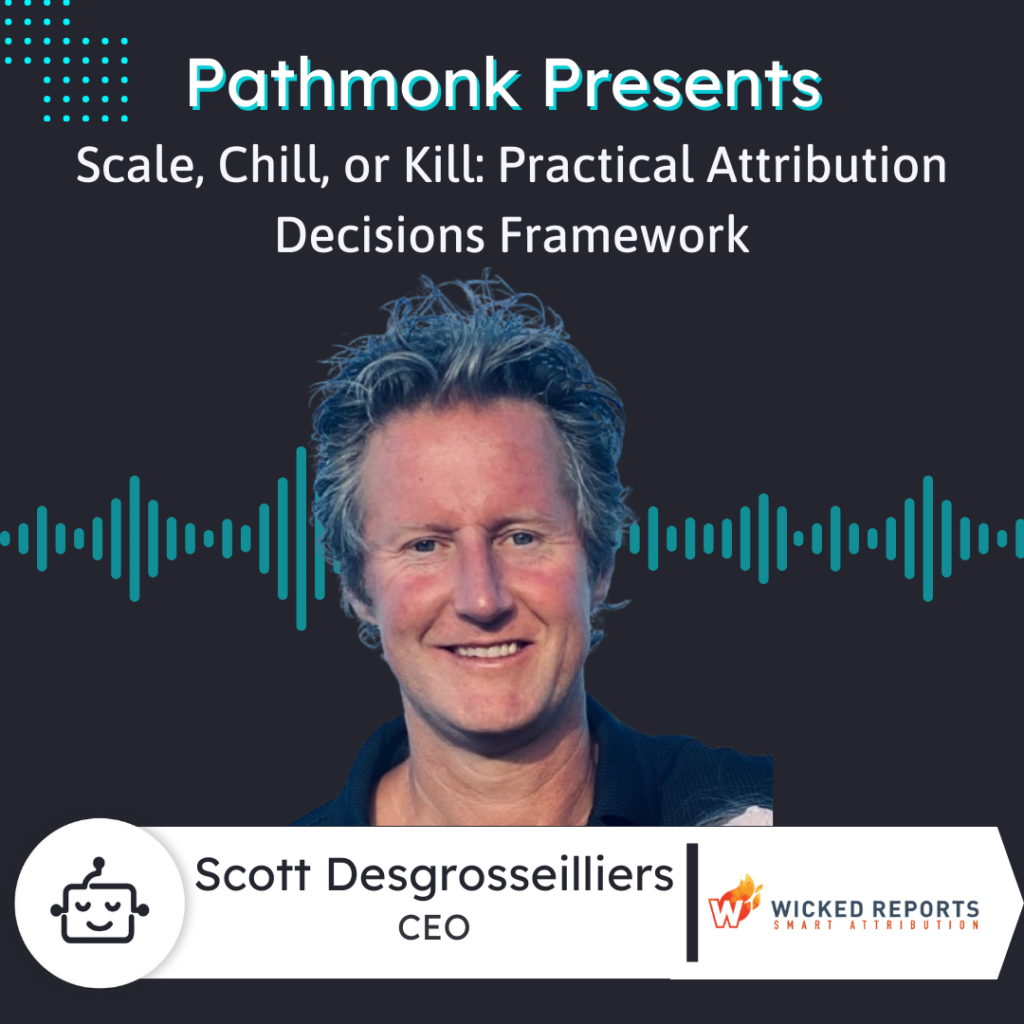
Introduction
Meet Scott Desgrosseilliers, CEO of Wicked Reports, a platform helping growth teams finally trust their attribution.
In this episode, Scott explains why ad platforms over-credit conversions and how first-party data reveals the real customer journey across seven to 100 touchpoints. He shares the “Five Forces” measurement strategy and the one-word campaign verdicts—scale, chill, or kill—that drive budget clarity.
You’ll learn why DTC brands (from $3M to $60M+) win by dialing in top-of-funnel insights, capturing emails and SMS early, and tying repurchases back to the original awareness ads. Scott also covers demo-to-purchase paths, website roles, and leadership lessons for keeping teams focused on outcomes.
Increase +180%
leads
demos
sales
bookings
from your website with AI
Get more conversions from your existing website traffic delivering personalized experiences.

Rick: Pathmonk is the AI for website conversions. With increasing online competition, over 98% of website visitors don’t convert. The ability to successfully show your value proposition and support visitors in the buying journey separates you from the competition. Online, Pathmonk qualifies and converts leads on your website by figuring out where they are in the buying journey and influencing them in key decision moments with relevant micro experiences like case studies, intro videos, and much more. Stay relevant to your visitors and increase conversions by 50% by adding Pathmonk to your website in seconds, letting the AI do all the work and increase conversions while you keep doing marketing as usual. Check us out on Pathmonk.com.
Hey everybody. Welcome back to today’s episode of Pathmonk Presents. Today we are joined by Scott Desgrosseilliers, the CEO of Wicked Reports. Scott, welcome to the show.
Scott Desgrosseilliers: Thanks for having me. Been listening to a few Pathmonk episodes, so I’m happy to now be a guest. It’s an honor.
Rick: Very good. I’m excited to have you. We’re excited to have this conversation and we just wanna start with the basics, Scott. So please give our audience an idea of what’s the big concept behind your company. If you were to explain it to a friend over a coffee, how would you describe what you do?
Scott Desgrosseilliers: Sure. Wicked Reports is a marketing attribution company, and that phrase doesn’t always mean a lot to marketers or people in general. But basically, when you do marketing online, at least half of your marketing spend is wasted, and you don’t really know which half is. What we do is create an easy-to-understand scoreboard for your marketing so that you can know where to move your marketing budget — to places that are working and places that aren’t.
Because a lot of times you can buy clicks cheaply, but it’s because the people don’t convert on your website either now or in the future. We especially appeal to full-funnel marketers who are going to market at the top of the funnel differently than at the bottom. Meaning: when they’re raising awareness and prospecting to get people interested in their brand, that’s a very different type of marketing and it takes longer for those people to convert — usually two weeks up to two months. And the ad platforms that you spend money on aren’t built to keep score and tell you when your top-of-funnel marketing is working.
But it’s the most important thing to do because if you don’t keep getting new eyeballs in, you’re not gonna grow. But it’s also the hardest thing to do. So the score doesn’t always look good when you first start. And so that’s what we aim to do.
Rick: All right. Whenever you mention attribution to marketers — and our audience is all of them — they’re just gonna listen. “Okay, so you’re telling me you have an answer here, you can help us with attribution.” I’m curious: are there any kinds of industries or businesses you feel your product really shines with at the moment? And when it comes to attribution, is there a specific problem in there that you help them solve? If you want to go into the details, that’s absolutely fine by us. Just want to understand a bit more about who you work with, what type of businesses, and how you help them.
Scott Desgrosseilliers: Our specialty is people selling D2C — so you’re selling to customers, not to businesses — because there’s a different journey and special ways to measure that are different. And our sweet spot is e-commerce companies doing $3 million to $60 million in revenue. We do have billion-dollar companies and we certainly have companies under a million that are rising, but that’s our actual sweet spot because they have enough volume and enough ad budget where we can make a real impact quickly.
Now one of the big challenges is that all the platforms are very biased and optimistic — the ad platforms — in how they’re doing. So if you go into Google and you’re also advertising on Meta and Microsoft Search, and then you go into your email and your SMS and your Shopify… if you add up all those conversions, they’re not going to match up. They’re going to be inflated in some areas and they’re not going to tell the true value of other things that are actually more valuable than they look.
The reason for that is the customer journey. As you mentioned in your intro for Pathmonk — there’s this journey. People generally don’t see an ad and immediately click and buy. Once in a while they do, but if they do it’s usually because they’ve already bought from you before. Generally we see seven to sometimes a hundred touch points it can take.
So originally, when we created this — we’ve been doing this for almost 11 years now — I thought the idea was: we’re going to take the real sales, which we call first-party data, and divide it by the touchpoints and tell you how much each point was worth. The trouble is that doesn’t really help because not every touchpoint is as important as the others. And if you take that approach and there are a lot of touchpoints, nothing’s going to look profitable even though your marketing is actually driving you forward.
So the challenge we solved is taking all that data — not just being mathematically accurate — but actually giving you a measurement strategy and framework so you can make a decision on all this data coming in. Because otherwise, why are you going to pay for another data source that just conflicts with all the other ones?
So I developed a framework called the Five Forces, and there’s a scale, chill, kill element to it — meaning in every campaign, we’re either going to tell you that you should be scaling and spending more, chilling (which just means hey, you don’t have to do anything here), or killing — which might not literally mean kill, but it could mean diagnose and improve the campaign, or kill it if you’re not going to do that because you’re losing money.
Rick: Trying to dial it back — so there’s an answer for every type of problem there, it sounds like, but it’s a pretty interesting framework: scale, chill, or kill. Okay. Interesting.
Now you brought up different channels. Let’s say someone uses Meta, someone uses Google Ads. When it comes to Wicked Reports, how do most people discover you? Are there any channels that have become your go-to for bringing in your customers? What is it like for you guys to find new business?
Scott Desgrosseilliers: Sure. Our top of the funnel is two things: this podcast — and YouTube. Then our middle funnel is case studies, mini product videos, or directing them to product pages. And then our bottom of the funnel is usually a live demo with a sales rep, or they just buy on the recommendation of their agency.
Rick: Okay. Fair enough. And in all of this — it sounds like top of the funnel, as you said, is podcasts and YouTube videos. Then people will be sent in some way or another — I’m assuming — to your website. How much of a role does your website play in pulling in your clients at the moment? Is it a big part of it, or do you feel you’re able to book demos from other channels? How does that work?
Scott Desgrosseilliers: It’s medium-high — I would say like a 7 out of 10. Our demos page has instant demos — almost like walkthroughs of specific outcomes. Because when you’re investing in software, you’re hiring it to get a job done. So we’ve listed some of the things that we can do and walk you through, with a couple clicks, how we solve that particular job that you want us to do. So people can get a flavor for it — they don’t have to get on a sales pitch. It’s more like a consultative approach where we show the jobs we solve.
Then you can book a live call with someone after you’ve seen that. So you don’t need a gatekeeper to see the product. But with attribution, it’s been around a lot, people have been burned with other solutions for one reason or another. So they usually like to talk to someone before they buy, is what we’ve found. Not always — but 90% of the time, I would say.
Rick: Okay. Yeah, that’s a big number. I’m curious from your experience, Scott: what makes a website actually convert? And right now you can draw from your experience from Wicked Reports and all the clients you work with. Maybe if there are any — besides the framework you just shared — but any tools or tactics you’re willing to share with us that worked wonders for you when it comes to website conversion?
Scott Desgrosseilliers: Spending a lot of time trying to get the email capture correct. A lot of people aren’t going to come to your website and buy right away unless it’s a Shopify store and a lower-priced product. Even with higher-priced products, if they’re on Shopify they’re sending multiple visits, checking reviews.
So capturing first-party data — if you can, their email address — so that you can then market to them. Taking time to dial that in sometimes makes big revenue gains for the brands who are good at doing that, because then they’re making more money off their website traffic. And that website ultimately can do a lot of things — but if you can have it as a lead engine, even if you’re e-commerce, capturing emails that you can then email and SMS — I’ve seen that move the needle pretty heavily.
Email and SMS — it’s an okay channel for us as B2B, but for D2C, it’s a really powerful channel still. It doesn’t get a lot of love, but it should, because they get a lot of conversions off those two channels. And that all starts with capturing their info.
Rick: Yeah. Look, as a consumer, I agree it’s effective. Many times — let’s say I buy protein powder — and then I get a reminder by email that says, “Hey, you’re running low potentially,” or I get an SMS and it works. I just go back to them and buy it. And that maybe there’s a promo or whatever it is. But yeah, I agree — it’s a very effective channel.
Scott Desgrosseilliers: And how we know that at Wicked Reports is because we tie that back to the ad that first made them aware of your brand. So if you’re buying the next protein powder off an SMS — that’s the dream client. You’re higher value than your original average order value.
Let’s say you buy protein — let’s say it costs the same just for the sake of argument — as the first time. You just doubled your value. But you might’ve first heard of that brand four months ago from some weight-loss video, or someone jacked in the gym — whatever all those different creatives that protein teams use.
Then you clicked again, then you checked reviews, then you did this and that, then you bought, then you opted in, then you bought — now you’re buying again. So we stitch that back and up the value of that top of funnel, because that’s the type of lag it can take. Supplements are competitive — we get a lot of supplement brands — it works as long as…
Particularly to your point: if they have dialed-in repurchase, then you can spend more on cold traffic. Stitching that together is what makes a brand win when otherwise it might look like the ads aren’t profitable.
Rick: Interesting. Thanks for breaking it down for us — just to understand how you tie it back to that first touchpoint.
Now, we can get super technical, Scott, but we’d love to also talk about you as a leader. Tell us a little bit about a day in your life. What’s a typical workday look like for you as the CEO of Wicked Reports, and what are the main things you focus on?
Scott Desgrosseilliers: The fun thing is there’s no typical day. I have structured time that I block out to work on projects — otherwise my day will get engulfed with other people’s needs. Which may be very valid needs, but I need to get my work done as a leader as well.
Setting the vision — it’s not something you do every day, but you gotta get crystal clear with the vision and communicate it often. I wasn’t good at doing that at first. Because once I could see where I wanted to go and set it one time, I thought everyone was on the bus… and they weren’t.
That’s part of what makes a visionary — you can see where you want to go quickly and how you’re going to get there. But what makes you a leader is you have to get everyone else going in that same direction. When I finally distilled Wicked Reports down to: “We’re going to do three things: measure, signal, act.” Measure the data, signal the ad platforms, and provide the action. And then people could see how all these different ideas were going to come together into one platform.
A day in the life: I’ll be on a podcast or two — today I’m on three. I’ve got a marketing call, I got a marketing EOS L10 meeting — that’s the executive weekly check-in. We’ve got one for the marketing and sales team today. Talking to some developers about a question around a feature. And then we have a war room, which is where we work on our quarterly goals and communicate.
Then I’m voicing over some training or looking over the scripts on some training we’re doing. We’re a team of 25, so we’re still reasonably small. A lot of the processes were either my brainchild or I helped create. So getting training tight is a challenge — because you have to get it out of your head so everyone isn’t coming to you.
And then making it concrete — trying to get a three-minute demo from a ten-minute ramble takes a week to script. That’s my day today — pretty packed.
Rick: Sounds like it varies a lot — and sounds like you have fun also, right? You have a smile on your face.
Scott Desgrosseilliers: Yeah, no — it is fun actually.
Rick: Good. There’s a term that comes to mind based on what you talked about — simple complexity. I can’t remember where I heard it.
Scott Desgrosseilliers: I’ve never heard that. That’s nice.
Rick: It’s being able to distill something complex into something simple — simple complexity. It’s not easy at all, but it sounds like you have a system down for being able to do that. And also for how you think — and being able to replicate that within your company so other people operate in a similar way.
Scott Desgrosseilliers: Yeah. The thing that took us a long time to get right — because of me, I think — was: you have to have confirmation that your customers are getting the value out of the product that they think. Of course, if they’re paying you again then technically they are, or if they’re logging in. But really — are they getting the real job to be done? Is it getting done to their satisfaction?
Because sometimes people will still… Pathmonk probably has a fair amount of analytics and things similar to Wicked Reports where people could be logging in but not really understand what they’re doing or not really get the value. It could be product reasons, it could be lack of framework, it could be a lot of things.
So focusing on actual evidence that the customers are getting the value — goes beyond NPS. NPS is not bad — but this was a big eye-opener for me. For marketing attribution, customers need to be moving budget because of the data. Otherwise they’re a churn risk. Why would they pay?
Some people still pay us and don’t do that. It’s puzzling.
With Pathmonk, they should change something about their website eventually based on the tool and services. They should be like, “Okay, now I’m gonna do this differently.” The more we focus on measuring and improving that, the better we do.
Rick: That’s a great point. Following that — talking about measuring and improving — I want to understand how you learn. There’s a flood of content out there. You’ve been doing this for more than a decade. So how do you stay focused and keep learning? Is there a specific routine or people you turn to for inspiration?
Scott Desgrosseilliers: I try to almost… it’s tricky, because as a CEO who loves to learn, I can get too far ahead of the market or crush my team with too many changes that the market isn’t ready for.
So I have to limit learning within marketing attribution and advertising in general. Otherwise I get too many ideas that throw us off the vision.
I now have a product manager who’s strong at saying, “Does this fit where we said we’re going?” And now I’m better at not even bringing ideas unless they fit.
So I limit my learning right now because I’m happy with where we’re going. I don’t want to get distracted.
So I try to learn from our customers. When they come to us with a challenge, that stimulates learning more than trying to set the next frontier. That’s something that comes with age.
Rick: You limit it because otherwise it’s easy to lose focus. That answers the question — boundaries define how you learn. Wise.
Scott, I want to thank you for being on the show today. As we wrap up, I want to give you the last word. If someone forgets everything about the interview today, what is one thing they should remember about the work you guys are doing?
Scott Desgrosseilliers: When you’re looking at your marketing, you should be able to distill each campaign down to one word: scale, chill, or kill. It doesn’t have to be with my framework — you can do it your own way — but whatever your methodology is, you should have ultimate clarity in one word. If you don’t, then you’ve got work to do.
Rick: Then maybe you can help, right? So if people want to check you guys out and see what you’re all about, how can they do that?
Scott Desgrosseilliers: There are three spots: wickedreports.com if you’re in the market for attribution; fiveforces.com if you’re interested in the measurement strategy and framework — there’s a course there; and I’m on LinkedIn — Wicked Reports Scott — should find me pretty easily.
Rick: Amazing. Scott, thank you again for being with us on the show today, and I wish you a wonderful day.
Scott Desgrosseilliers: Thanks. Thanks for having me.
Rick: Bye everyone.
Scott Desgrosseilliers: Bye.




